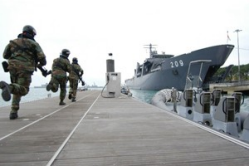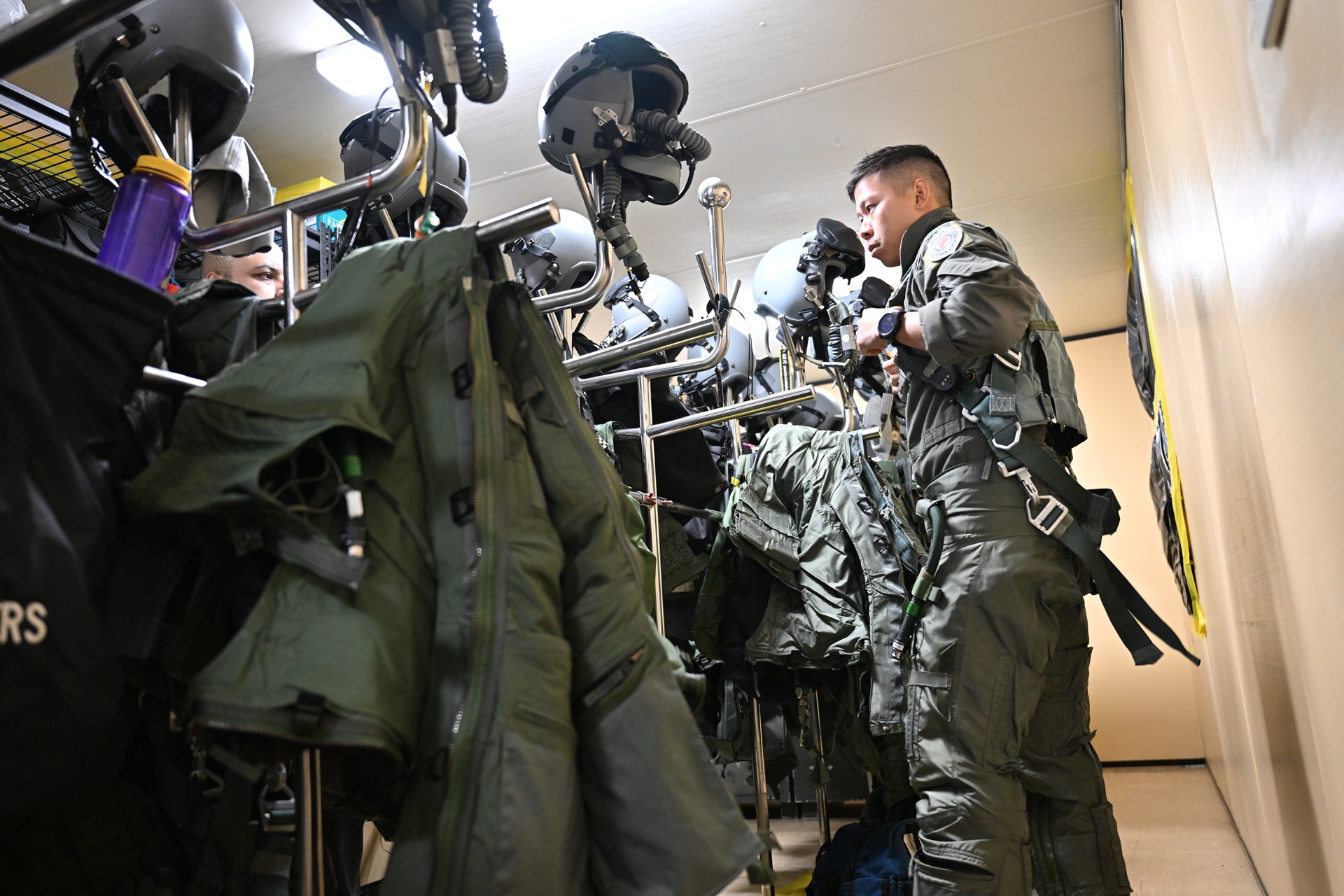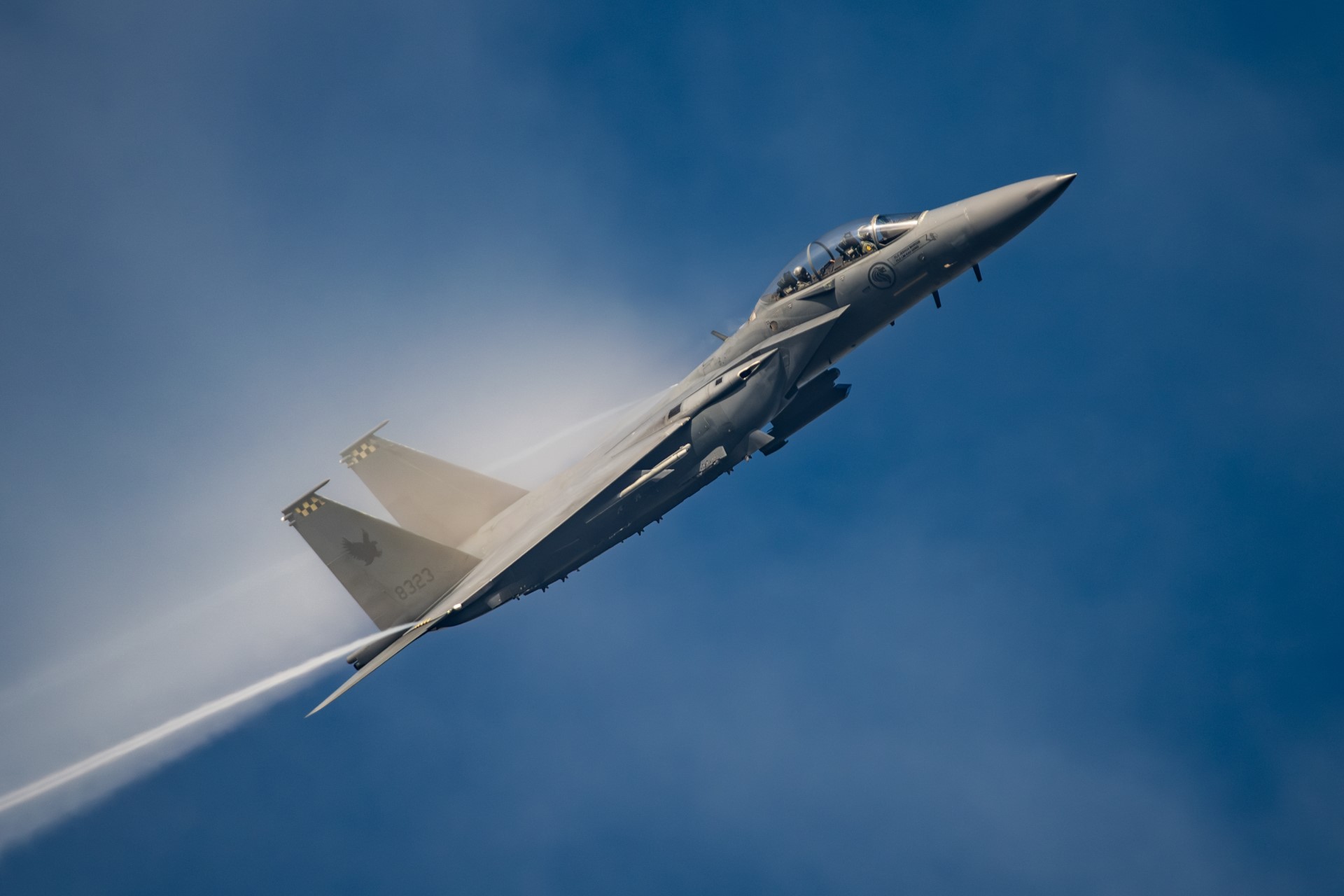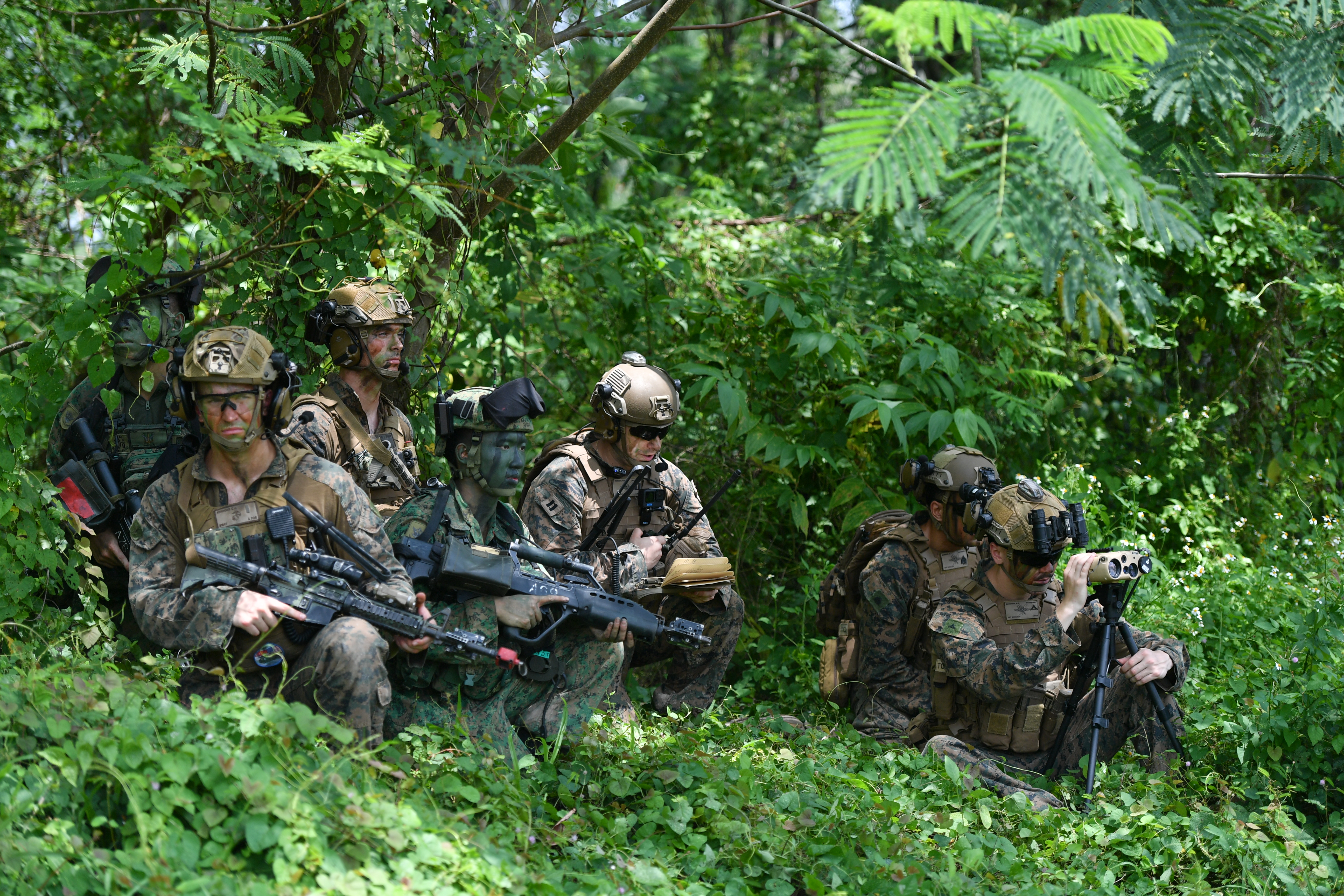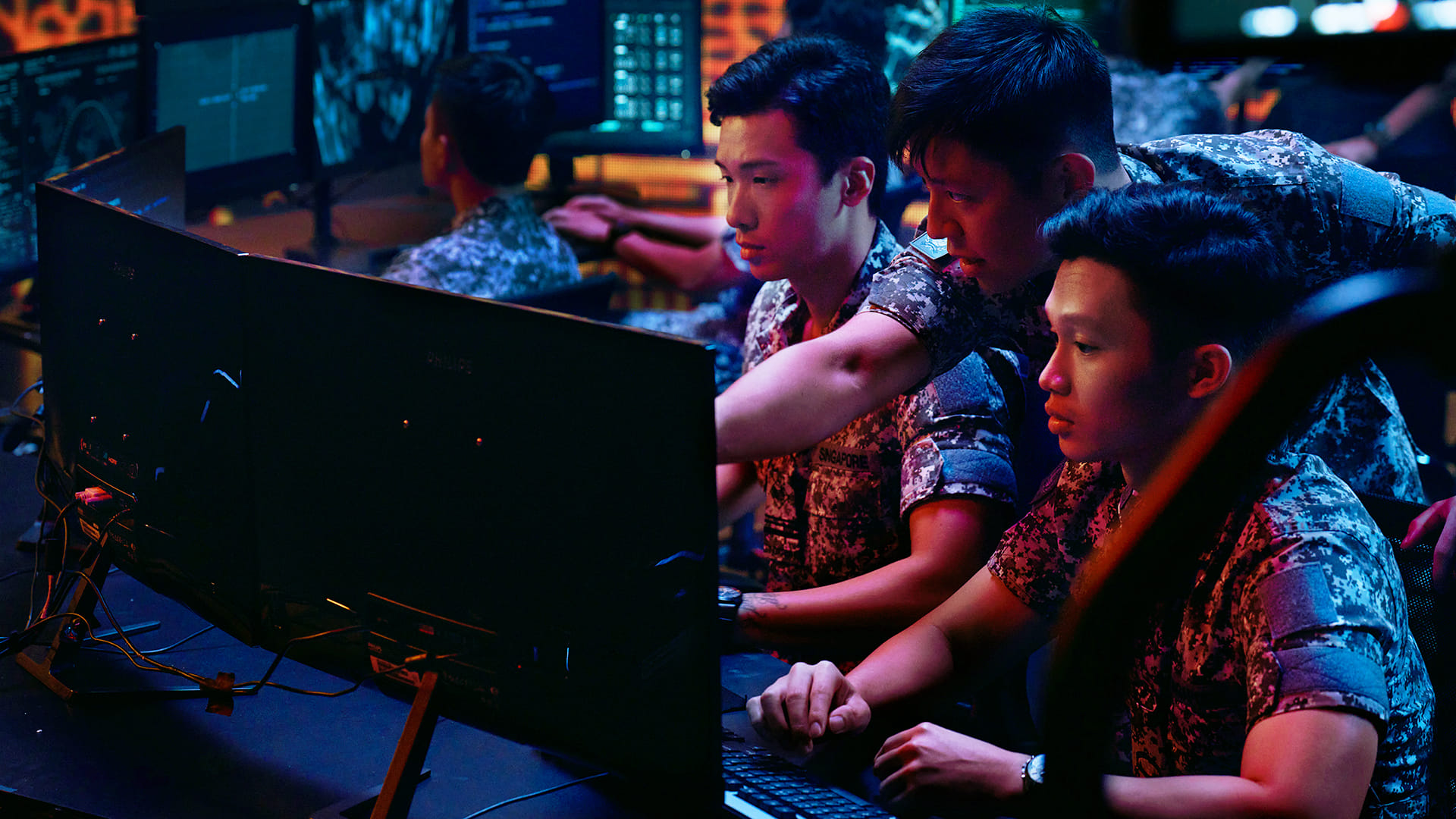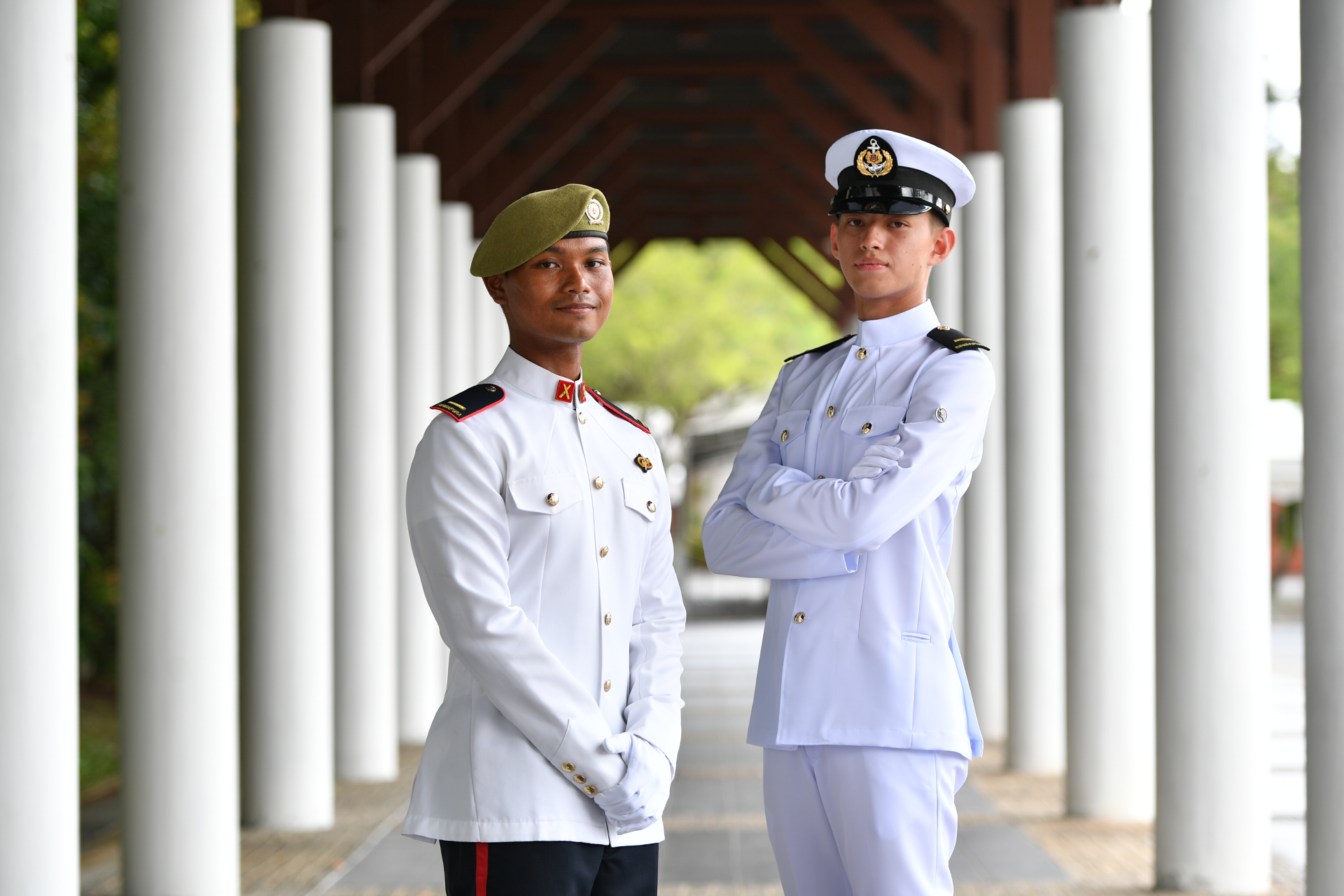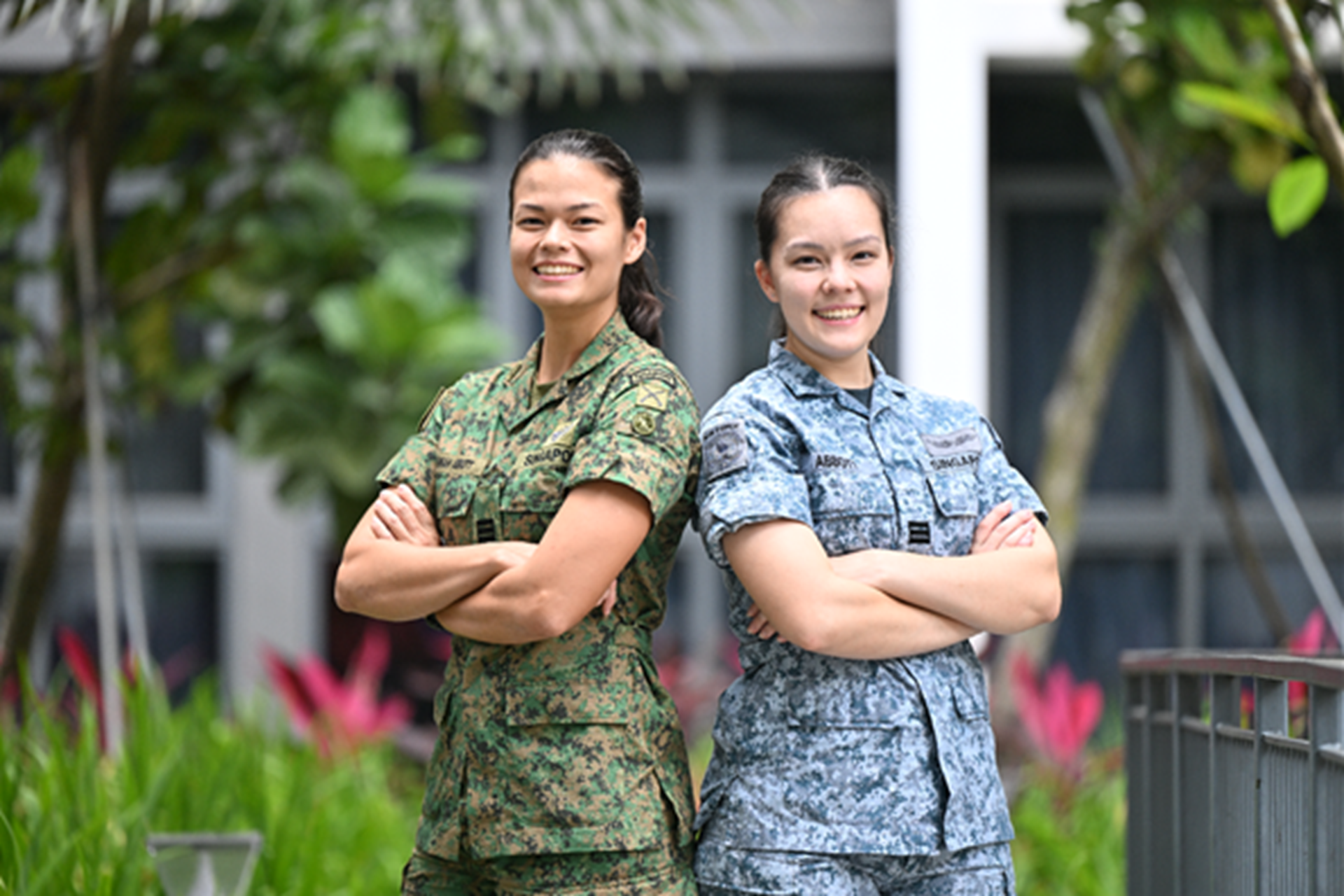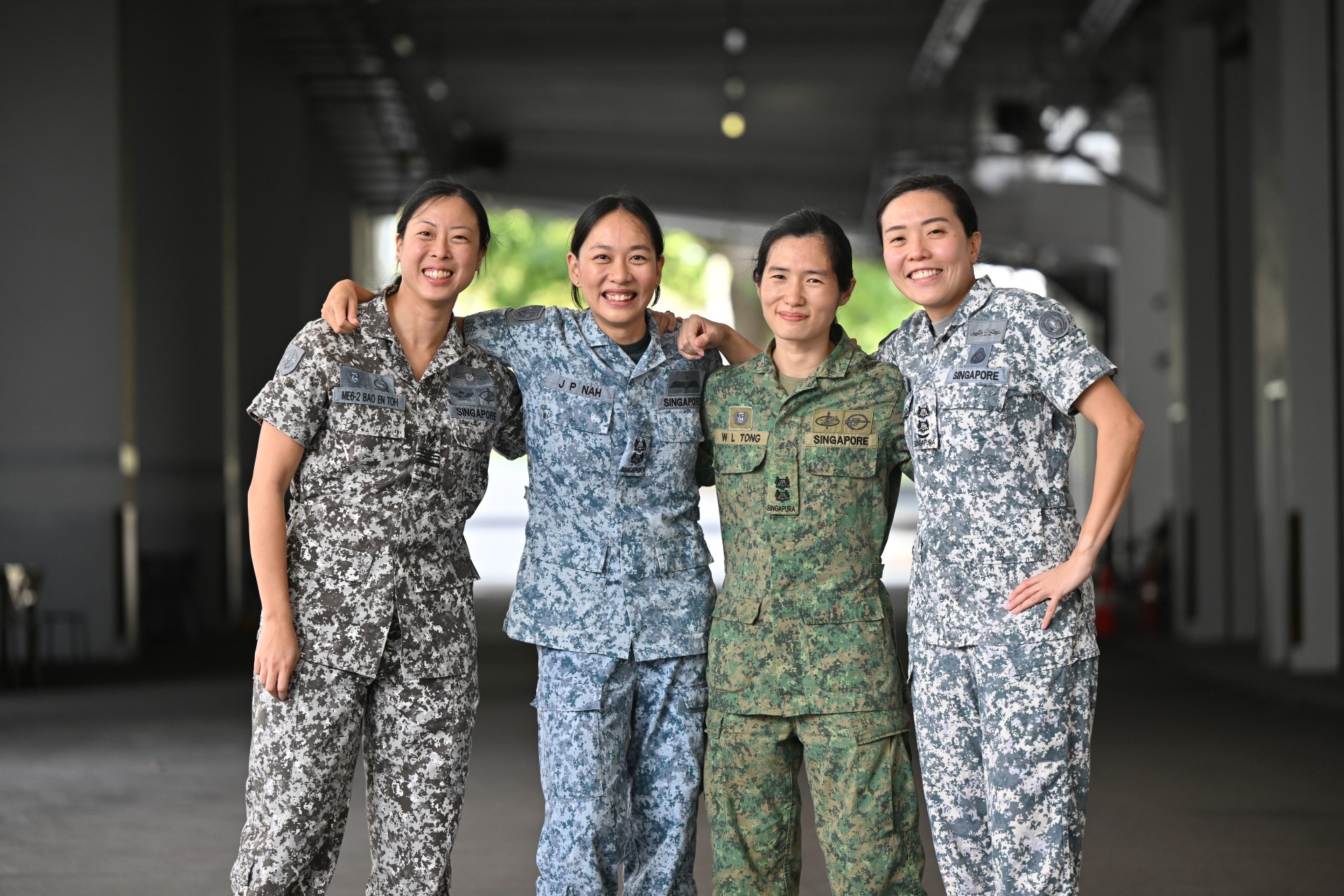AREA SECURED - BASE DEFENCE SQUADRON
STORY // Gail Wan
PHOTO // Chua Soon Lye
Armed with M-16 rifles and live rounds, they patrol the boundaries of Changi and Tuas Naval Bases, the wharves and even go on board ships to ensure that security of the bases is not compromised. They are also responsible for the enforcement of military laws and regulations, and are ever ready to provide support for base contingency operations. Regimental Policemen they are not, but rather, a newly-minted vocation that straddles both land and sea operations - introducing the Sea Soldiers of Base Defence Squadron (BDS).
The volatile security climate following the 9/11 terrorist attacks in the US was the catalyst that sparked the shoring up of boundary defence and force protection measures.
It prompted the formation of BDS, made up of Changi Defence Squadron (CDS) and Tuas Defence Squadron (TDS), that were tasked to protect assets and personnel within the two naval bases against land and sea threats during peacetime and war.
"BDS involves more than just defence, because we also provide force protection in view of the new threat environment," said Commanding Officer of CDS MAJ Danny Tan (left).
"It should evolve into a force to be reckoned with, which I think is a very important factor in force protection - in having a strong deterrence factor that the would-be adversary would think twice about taking any action against us."
Deterrence, Detect, Defend and Defeat are the four 'D's that make up the security philosophy of the squadron.
"To deter, as my CO said, is to have a strong and credible force that can be seen. To detect will basically be all the technology in place for surveillance. But technology will not be sufficient on its own. What's more important is actually the people their sense of being vigilant and alert," explained Company 2IC of Base Security Company, CDS 2LT Chan Jingzhong (left).
"Finally, our role is to defend, and when attacked, we definitely want to defeat the enemy."
BDS operations on land range from daily surveillance with radar and CCTVs and fire-fighting during dry spells, to responding to any incidents affecting vessels berthed at naval bases in the event of accidents.
2SG (NS) Yeo Boon (left), who does security surveillance in CNB during his ICTs, is schooled in the rules of engagement which are used in the event of intruders.
Along with fellow NSmen, they also revise the use of weapons and communication sets before they are deployed to the various outposts.
Always vigilant, always alert: Daily operations include (top) surveillance from the watch towers and (above) patrolling in the Rigid Hull Inflatable Boats (RHIB) around surrounding waters.
"For different stations, suspicious signs will be very different. For my case, we are stationed in a tower, so we will be looking out for any suspicious characters that are moving outside the fencing and any vehicles that are coming in without permission, or any fishing boats that are near our post area," he explained.
As for the sea component of BDS, the 'eyes' of the squadron are observation posts on bases that are manned 24 hours a day and mounted with machine guns.
All sea traffic is monitored and any suspicious threats will be verified before sending the Rigid Hull Inflatable Boats (RHIBs) out to intercept crafts that trespass in our protected waters.
Like a checkpoint in the sea, basic patrols and sea screening is also carried out, especially for vessels entering CNB. When foreign warships are preparing to berth, all the supporting vessels, like tugboats and pilot boats, have to be checked first before being allowed into the base.
The RHIB crew will also have the opportunity to go for special courses.
During Ex CARAT, US personnel from Mobile Security Squadron 7 will be here as instructors to the men on some of the techniques for sea screening. The Naval Criminal Investigation Service will also show them how to conduct arrests.
Sea Soldiers are on stand-by for fire-fighting operations especially during hot and dry spells.
Sea Soldiers are trained in CBR defence and are expected to be familiar with, and comfortable in, the protective gear
The main difference between operations in the two naval bases is that TNB does not host foreign ships. However, they have their own set of challenges to address.
"We are situated quite near commercial shipping lanes. And we are surrounded by two commercial shipyards that are actually quite busy," said RHIB Platoon Sergeant, TDS, 3SG Ryan Teo (left).
"So we still need to maintain a very high level of readiness, especially for my guys on the ground because at any moment, any commercial vessel can be a threat in disguise."
"Our guys are actually the fastest responders on the ground that we can mount, so how they react will determine how much damage we can prevent. That's why they are ready to be activated," he added.
Anyone who intrudes into protected waters, even fishermen who unintentionally stray into the area, will be intercepted by the RHIBs. The offenders will have their particulars noted down and pictures taken for visual identification, with the information stored in a database.
"Maritime threats around the world are actually increasing, so we let the men know that and explain to them why Singapore is a prime target...They are quite self-motivated, they know that their job is important obviously nobody can react as fast as them," said 3SG Teo.
Vehicle checks and undercarriage screenings are essential access security measures that are carried out vigilantly by BDS personnel everyday.
The mobile security team on duty making its round on the naval base.
To be the first to respond to any situation on the base, the servicemen have to be always alert and vigilant. They are on duty 24/7 throughout the year, including Sundays and public holidays.
What makes it tougher is that no one knows when something may happen, if it happens at all.
As a famous Chinese saying goes: you muster an army for a thousand days, but deploy them for only a moment.
2LT Kang revising the technical handling of the M-16 rifle with the sea soldiers.
To ensure that that the men do not get complacent or discount the possibility of an attack, TDS officer trainer 2LT Jasper Kang makes it a point to stress to his men that "your one mistake of negligence is going to cost everyone's effort in protecting the base".
"That's why when we end a certain lecture or training, we will also stress that we should always stay vigilant. We will also show them pictures of destruction in other countries - when vigilance was lowered and protection was lost," he said.To test the Sea Soldiers' operational readiness in a realistic setting, a week-long exercise last year saw simulated surprise attacks carried out on both bases."During that period, there were numerous attacks carried out, both on land and at sea, and all of us had very little sleep, but everybody still persevered throughout the exercise. Although the men were tired, they gave their best. It was very commendable," recalled 3SG Ho Choon Sing, a platoon sergeant with CDS.
"Doing duty can be tough and tedious, but if you decide to make it a more enriching experience, the bonds you foster through all this hardship are very strong," added platoon sergeant 3SG Timothy Yeo.
"Basically, we keep morale high by just remembering that we have a job to do. It is a job that someone has to do, so we are not complaining."
As for tips on how to be on your toes all the time, 2SG (NS) Yeo said it was a matter of good scheduling, being well-hydrated, having proper rest and, of course, a dash of caffeine helps them stay fresh.
"The duty schedule is important because we have to make sure that all the duty personnel have enough rest to be in good condition to carry out the duties," he advised.
"When we are on duty, we need to wear the Skeleton Battle Order (SBO) and carry our weapons, so we drink more water because the weather is quite hot nowadays, and it can also keep our body in the best condition. Of course, drinking coffee is one of the ways to help us stay alert and mentally fit to do the surveillance work."
1SG Yuen demonstrating to trainees from the sea soldiers course how to handcuff an offender properly.
There are both Army and Navy regulars in this squadron, which is under the command of HQ Fleet.
A large number of NSmen in BDS are also from other Army units, while former Navy NSFs and ex-Navy regulars who have ORD-ed make up the rest. The majority of the NSFs are trained in-house as Sea Soldiers.
The Sea Soldier course is currently into its ninth class.
The trainees go straight from BMT into the three-month course before commanders are selected from the good performers within that pool.
Sea Soldier training is conducted in CNB, and upon graduation from the course, the soldiers are distributed between Changi and Tuas.
1SG Yuen Tat Hoong, who was previously with the SAF Provost Unit, was posted to BDS to assume the role of Sea Soldier Course Commander.
He conducts lessons on policing duties, what Sea Soldiers should do when they face violent offenders how they should react, when to use force and when to fire.
"When they first came, they were just young adults. During the training, we taught them to have integrity and teamwork, to understand their roles and responsibilities as citizens of Singapore while serving their NS here."
"When they completed Full-time NS, after having played their role in defending the base and their country, that's when we really saw them as Sea Soldiers," he said.
"The Navy plays a part in defending our seas. As for Sea Soldiers, we defend the people who defend our seas, we guard our camp assets; the ships and the compound."
"Whether big or small, we all play a part in the defence of our land."
The Sea Soldier course is three months long and aims to maintain trainees' fitness level while imparting operational skills to them. Course components include:
- IPPT and SOC training and swimming
- Basic Seamanship and lessons on identification of various ships
- Fire-fighting course
- Heli-ops package
- Improvised explosive devices familarisation training
- Chemical defence package
- Training in various weapons such as M-16, SAW, GPMG and M-203 at ranges and live firing
- Sailing and live firing at sea
- Law enforcement training
- Signal lessons
- Urban Operations, protection of key installations, section training and rules of engagement lessons
A summary exercise is conducted at the end of the course for evaluation.
For MAJ Tan, the most important cog in this whole wheel that makes up BDS, is the people behind it.
"I focus a lot on the heartware because in the physical protection system, the important part is how to integrate people, equipment and processes. I think human capital is very centric to whatever we are doing," he reiterated.
He feels it is important to have the men's welfare at heart, including making their environment safe and conducive for them to perform.
"I always emphasise the importance of safety in training because if you don t have that, then I think you can forget about going into operations during tense periods," he said.
"To be sensitive to their needs, we provided a resting corner for them, with various household necessities to make them feel at home, since they spend a considerable amount of time here."
As for future developments in operations, MAJ Tan said the squadron is looking into how the unmanned vessels can contribute to homeland security and how it can further augment current capabilities, to enhance response as well as to serve as a very strong deterrence.
Ultimately, BDS hopes to find its place in the 3G SAF.
Personnel from the Republic of Singapore Navy's (RSN) Base Defence Squadron (BDS) can finally shake off the misconstrued Regimental Police-image.
They now have a new vocation - Sea Soldier.
In the past, full-time National Servicemen posted to the squadron were either Regimental Police (RP) or Infantry Section Leader (ISL) by vocation, even though their duties covered a plethora of land and sea skills.
"You are now officially known as Sea Soldiers, a naval vocation in the RSN," declared Deputy Fleet Commander, COL Tan Tow Koon, in a ceremony on 29 Mar. "You are no longer an Army vocationalist serving in a naval base."
Like many of his peers, Tuas Defence Squadron's RJIB Platoon Sergeant 3SG Ryan Teo is delighted with the news.
"Ever since the sea soldier course was started, it has been the hope that this vocation will be formally recognised. Because what we are doing is actually a lot more - it's a lot of effort and sacrifices from many people," he explained.
I am already completing my NS commitment soon, but I hope that in the coming few years, people will know what I have done in my NS and hopefully it will be accorded a certain amount of respect and recognition."
With the Navy's bases situated along the coastal area of the busy Singapore Straits, where more than 1,000 ships ply through daily, BDS plays a crucial role and it has to be alert and vigilant 24/7.
"One of JI's plans was to attack the US ships when they transist through the narrow Johore Straits. The location marked out by JI is not very far from CNB. Reconnaissance was also conducted on CNB from sea," remined COL Tan.
"We must never be complacent about what we are doing in the base. Never let down your guard regardless of whatever pressure that comes along your way."
BDS trainees have to go through three months of intensive physical and mental training, followed by four weeks of on-the-job training before they graduate as Sea Soldiers.
